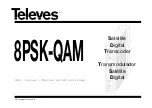Si4010-C2
148
Rev. 1.0
35. C2 Interface
The devices include an on-chip Silicon Laboratories 2-Wire (C2) debug interface in-system debugging with
the production part installed in the end application. The C2 interface uses a clock signal (C2CLK) and a bi-
directional C2 data signal (C2DAT) to transfer information between the device and a host system. The C2
interface is intended to be used by the Silicon Labs or third party development tools. It is not intended to be
used for any other purpose. It can be completely disabled per user programming for fully programmed
chips.
35.1. C2 Pin Sharing
The C2 protocol allows the C2 pins to be shared with user functions so that in-system debugging. This is
possible because C2 communication is typically performed when the device is in the halt state, where all
on-chip peripherals and user software are stalled. In this halted state, the C2 interface can safely borrow
the C2CLK (GPIO[5]) and C2DAT (GPIO[4]) pins. In most applications, external resistors are required to
isolate C2 interface traffic from the user application. A typical isolation configuration is shown in
Figure 35.1 along with the connection to the standard Silicon Labs 10-pin debugging interface header.
Figure 35.1. 10-pin C2 USB Debugging Adapter Connection to Device
GPIO5
C2DAT
C2CLK
VDD
GPIO4
VDD
Device
1
2
3
4
5
7
9
6
8
10
1k
1k
VDD
VDD
1k
VBUS (~ +4.6V) Can be used to
generate local VDD
50k
50k
GPIO[4]
For application bidirectional use,
isolated from the C2
R1
R2
R4
USB debug adapter
10 pin header connector
470
LED
1mA max
TMS
C2CLK
1k5
SW_GPIO4
R6
R5
If pushbutton on keyfob
development board, then it
has to be isolated by R5
For debugging chain to
work, LED must be
isolated by R6


















